You're
at Overcoring

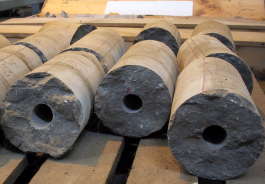
The overcored
specimen is inserted into the biaxial pressure cell to measure
Young's modulus based on the thick-walled cylinder solution.
Poisson's ratio is usually assumed to be known for a specific
rock or measured in the laboratory using an extracted EX-size
core.
|
Overcoring
methods
Overcoring
methods are measuring in situ stress based on the stress relief
around the borehole. The relief of external forces by overcoring
causes the changes in
- borehole
diameter for "USBM deformation gage";
- strain
on the borehole wall for "Triaxial strain cell",
or
- changes
in strain on the flat end of the borehole for "Doorstopper".
If the
elastic properties of the rock are known, the changes in borehole
diameter or strains can be converted to in situ stress in
the rock.
USBM
deformation gage - method
The USBM
three-component borehole deformation gage is designed to measure
diametral deformations of an EX-size (1.5" in diameter)
borehole during overcoring a concentric borehole (6"
in diameter). The diametral deformations are measured in three
directions (60 degree apart) in the same diametral plane.
The field
procedures consist of drilling a concentric EX-size borehole,
installation of the deformation gage, and overcoring a stress
relief borehole.
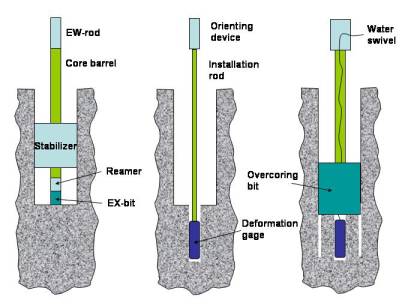
Click the above picture to get the full size drawing.
USBM
deformation gage - instrument
The
borehole deformation gage consists of six strain-gaged cantilever
transducers made out of heat-treated beryllium copper. At
the free end of each cantilever, tungsten carbide button is
mounted to make a contact with the borehole wall. A pair of
transducers, placed 180 degree apart, measure diametral deformation
of the borehole.
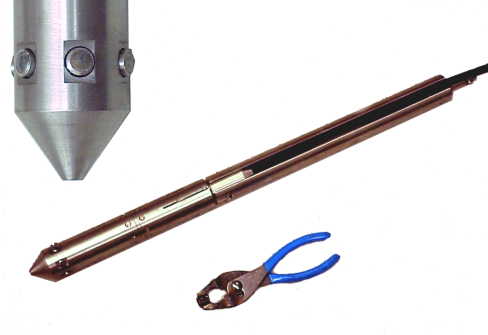
USBM Deformation gage
USBM
deformation gage - theory
If
the borehole is oriented in 0y direction and the xz plane
is perpendicular to the borehole, the diametral deformation
Dd at q
(angle measured counterclockwise from 0x oriented with the
a pair of buttons) can be represented as follows based on
the theory of elasticity and the Kirsch solution.
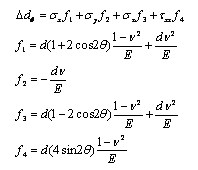
The
diametral deformations DD at q=0,
60, and 120 are measured from field testing. Young's modulus
E and Poisson's ratio n are measured
from the extracted core. If the stress component, sy,
parallel to the borehole is known (usually assumed to be zero
for shallow measurements), the stress components in xz plane
can be calculated as follows.

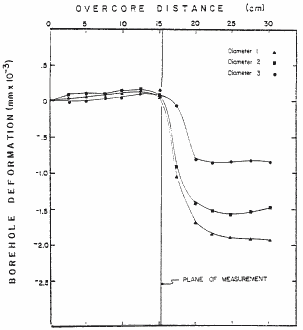
Three channels of diametral deformations logged continuously
as the deformation gage is overcored. As the overcoring bit
passes through the plane of measurements the stresses are
relieved and the results are shown as diametral deformations
(After Fisher, 1982).
|
|
|
|
Hooker,
V.E. and D.L. Bickel, Overcoring equipment and techniques
used in rock stress determination, USBR IC-8618 (1974).
Hooker,V.E,
Aggson, J.R., and D.L. Bickel (with appendix by W.I.
Duvall), Improvements in the three-component borehole
deformation gage and overcoring technique, USBR RI-7894
(1974).
Fischer,
D.J, Near surface stress measurements in a candidate
rock mass for superconductive magnetic energy storage,
MS Thesis, University of Wisconsin-Madison (1982).
Goodman,
R.E., Introduction to rock mechanics, 2nd edition, John
Wiley and Sons (1989).
USBM-RI9582
|
|